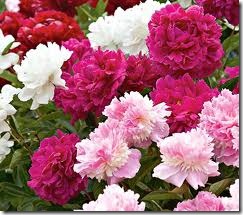Perennial peonies offer beautiful, full blooms in the spring landscape. Peony hybrids or garden peonies (Paeonia albiflora or Paeonia officinalis) grow 2 to 3 feet tall and come in a variety of flower types, including single, double and Japanese. These low maintenance plants thrive in cooler regions and make for stunning, though short-lived, cut flowers.
Plant Description
-
The classification of peonies refers to their flower form, according to Ohio State University. The flower has at least five large outer petals and a center of stamens. These flowers bloom in late spring to early summer in any color, with the exception of blue. While peony blooms usually only last a week, planting early, mid, and late season peonies prolongs the time frame that your flowers bloom.
Planting
-
Like most plants, peonies require moist, fertile soil. When choosing a place to plant a peony, choose one that receives full sunlight. If planting near a wall, allow for at least 2 feet of space. September and October provide the opportune conditions for planting peonies, as the fall will allow the buds to establish themselves before winter. Plant peonies 3 to 4 feet apart, incorporating organic matter and fertilizer, and place eyes of the buds in the ground only 2 inches from the surface.
Plant Care
-
Spring provides the best time for mulching, as a 2- to 3-inch layer of organic matter helps to retain soil moisture and keep down weeds. Removing the mulch in the fall and cutting back the peony plants to 3 inches above the dirt reduces the chances of fungus and other diseases overwinter. Also in the spring, an application of a low-nitrogen fertilizer encourages plant growth.
Plant Division
-
As peonies do not transplant well, divide plant clumps only when flower production starts to suffer from overcrowding, usually every 10 to 15 years, according to North Carolina State University. The best time to divide and replant comes in fall when peony buds become red and swollen. Dig up the plant, and cut apart in sections of three to five eyes using a sterilized knife, and apply a fungicide to the cut surfaces to prevent disease.
Diseases
-
According to Ohio State University, commonly occurring peony diseases include botrytis blight and leaf blotch. These fungal diseases appear during wet springs and affect leaves, stems and flowers of peonies. Leaf spot, reports North Carolina State University, appears after flowering, popping up in small reddish spots that enlarge and turn purple-brown as the disease matures. Botrytis blight attacks buds and stems, causing them to soften or turn black. The removal and destruction of infected parts, especially in fall, helps control and prevent the disease the following year.


Deprecated: strpos(): Passing null to parameter #1 ($haystack) of type string is deprecated in /home/agriviek8Qv/agriviet.net/public_html/wp-includes/comment-template.php on line 2522